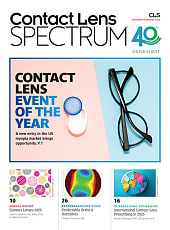Collaborative Dispensing
In the contact lens arena, new innovations are always around the corner, and putting them into practice is an office-wide effort.

EB connected with Jennifer Seymour Brusven, LDO, NCLE-AC, ABO-AC, AAS, of Yesnick Vision Center in Las Vegas, and one thing was clear: Success comes naturally to a practice that is interlocked in collaboration—from the optometrists and opticians to the front desk staff and the company representatives.
“Everybody kind of puts in their two cents. As we’ve grown together, the value of each other’s opinions has only gotten better. We know that’s rare,” she shares. “Any office that has that magic will absolutely discuss it. You cannot miss it when you walk in the door, and our patients know that, too.”
Here, she shares insight into the collaborative process that spells success for this Nevada practice.

EB: What is the usual process for launching a new contact lens?
Jennifer Seymour Brusven, LDO, NCLE-AC, ABO-AC, AAS: We have worked hard as an office to have a strong relationship with our reps with open lines of communication; we see them no less than twice a month.
[The reps provide] a comparison of [other] contact lenses [the new design] compares to, and then we discuss, “Oh, who on the schedule the next week might benefit?” We have a melting pot of experience, so we powwow at the desk together [to see] who can contribute. Even at the front desk, [they share], “Hey, this is what we hear.”
The way the office is designed, the contact lens room is kind of a walkway, and everybody sees it. [No one is] hiding in an office somewhere, and [that creates] an out-there partnership. The doc sees them, “Hey, you’re here—cool. I got five minutes between these two patients,” or [the reps] come and sit with us for lunch.
EB: How does following up with patients contribute to determining the success of a new contact lens design?
JSB: Contact lens follow-up three days later in the office was tradition years ago in the field, but I think a lot of doctors have stepped away from [that because] it’s chair time that may or may not be beneficial.
I’m less about that seven-minute exam room time [and] more about that 10-minute exam room time.
[Those extra minutes] in the room can spread back out and get reinforced by the rest of the team; it makes our jobs easier [and goes] a long way in annual retail sales—accessories, eye drops, whatever the case may be. Sometimes, the money is in the room already. You don’t have to chase it with another patient.
For new contact lens wearers, our trainings are done separately. Everybody knows who’s training, and [when it’s successful], it’s this whole celebration, and that makes the patient more excited, too. Even when it doesn’t go well, there’s no negativity: “Hey, you know what, let’s get these great habits down and we’re going to see you again to fix this.”
EB: How does your patient base determine the practice’s contact lens inventory?
JSB: We are a low vision clinic, so we see complicated cases all the time, but what that brings to the table is that we have one of the most expansive soft contact lens trial inventories. Then to have a company invest in us and just hand us the tools happily, “Please have this so that we can grab this patient,” is something that isn’t done anywhere else.
Usually, people come in like, “Oh my gosh, you have the trial in my size?” There’s excitement. Because we already attract the outer rim of patients, when they walk in—it just reinforces [that excitement]. Our situation is a little more unique because we do invest in that expanded program; we consider it investing in our patient care. Our patients are already excited because they know they can come to us, we’re going to have those options available for them, and they’ll be taken care of.



